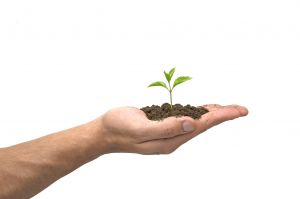
It’s been a wild spring here, with hail and pouring rain and temperatures that are near freezing. However, the garden is calling and so is the soil. Soil is the foundation of the health of your garden.
In your vegetable garden, you likely have a whole lot of soil at the moment. If you live somewhere that is a little warmer, you may also have perennials or annual food crops growing. If you live somewhere quite cold, your garden might be just stretching its tendrils and waking up.
In the winter, adding a cover crop like those fava beans or rye grass can help your spring soil. You don’t eat these cover crops – your garden eats them. Mulch the remains of the crop into the spring soil, and you have important nitrogen and lots of fiber for the garden. This year’s cover crop experiment worked to a degree. I was testing out fava beans as a cover crop, but given our Pacific Northwest rain I think that the seeds turned into soil instead of growing them into big, nitrogen-rich mulch plants. There are perennials and early greens like sorrel popping up, with more to come, so I need to work around those. There is also a layer of leaves over part of the garden, leaves that I added to provide a bit of protection for the winter. What’s left of the cover crop and the leaves will go into the garden soil and enrich it for this year’s new plants. However, given the blasting rain in the Pacific Northwest and the ice and snow elsewhere, it’s good to replenish your soil regularly to ensure that all of those nutrients don’t head right off into the spring runoff.
One way to replenish your soil is through fertilizer. You don’t need to use artificial fertilizers. A kelp-based organic fertilizer will do your garden good as well. Natural fertilizers are like the health food of the fertilizer world – gardens use up these nutrients slowly over time instead of having them move through the system all at once.
However, fertilizer is only one tiny piece of a regular garden soil maintenance program. Add compost into the garden to increase soil aeration and soil fertility after the long winter. If you’ve lost soil over the winter, add high-quality compost or a product like Sea Soil to add good fertility to your garden. While potting soil is good as a lightweight soil mix, it’s also fairly lightweight on the nutrients.
Although it might seem far away, summer is creeping up on us. With it will come days that are hot, days when your plants start to wilt and wither. What you need is fiber for your soil. Yes, this means mulch. Rough pieces of material provide nutrients for your garden, but they mostly provide roughage – they create spaces in the soil that maintain soil porosity and allow air and water to stay in the soil. This means that on a hot summer day, your plants will have hidden patches of moisture to rely on.
What do you do to help your soil stay fertile throughout the gardening season?
Image courtesy of eocs at Stock Exchange.

